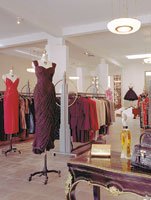Past Perfect: On the Hunt for Vintage Couture
Contrary to popular convention, aged and weathered looks are often no obstacle to a good Hollywood comeback.
Like once-forgotten celebrities rising again from cinema archives, designer clothing from decades past is getting a second chance under those Klieg lights, often shining brighter than its modern-day counterparts.
Vintage clothing is the tool celebrities and movie and TV directors use to stand out from the madding crowd. Retailers and stylists say the upsurge in vintage clothing sales represents a backlash against the cookie-cutter fashions that originated from stores such as the Gap in the 1990s and the minimalist looks of the decade. For the customer, it’s like taking an archeological journey that may or may not lead to unearthing treasure.
“I can go buy Vogue or Elle and see the new Versace dress and everybody will know what it looks like, but if you come into our store, you’ll enter the unknown and have no idea what you may find,” said Katy Rodriguez, owner of the 2-year-old Resurrection boutique on Melrose Avenue in Los Angeles (as well as the two New York locations), which carries Giorgio Sant Angelo, Courreges, Pucci and 1960s dresses created for the Elizabeth Arden boutique in New York.
Rodriguez said her awards-show business has doubled in the last year and has received strong support from the Dixie Chicks, Frances McDormand, Lenny Kravitz and Sheryl Crow.
If local celebrities don’t first head to the designer’s archive using their own wherewithal or relationships with the couturier—think Julia Roberts’ archival Valentino dress at last year’s Academy Awards—they or their stylists may visit Decades, Lily et Cie, Golyester and a number of shops in Los Angeles that have established themselves as the resource for vintage. Those stores will either sell or loan out items, depending on the needs of a star, movie or TV show.
Rita Watnick, owner of Lily et Cie in Beverly Hills, Calif., credits celebrities Demi Moore, Winona Ryder and Renee Zellweger with legitimizing the look. Moore wore a 1940s studio gown from Lily to the 1992 Oscars. In addition, Watnick said she was receiving calls for years following Ryder’s appearance at the 1994 Oscars, as customers sought out the actress’s vintage couture Pauline Trigere gown.
“They’ve had a significant impact on my business,” said Watnick, whose store carries more than 500,000 pieces. “They know the appeal is that no one else has it. There’s an element of surprise and surprise is genius. It confuses people.”
The wearing of vintage clothing also eliminates possible dress duplication among the stars, a faux-pas that occurred in 1995 when actress Jennifer Tilly and supermodel Vendela selected the same Isaac Mizrahi gown in different colors to wear to the Oscars.
Watnick pointed out that wearing an existing gown doesn’t always make the fitting easier. “It took 52 hours to alter Zellweger’s piece,” she said.
Vintage clothing popularity prompted the Paper Bag Princess in West Hollywood, Calif.—a haunt for Chloe Sevigny and Julia Roberts—to launch an online shopping site last month, a site so popular that one customer hacked into it before it was live to make her purchases. Owner Elizabeth Mason, whose second book, “Valuable Vintage,” is due out in April, says her business has doubled in the past two years.
Mason has also hit upon another lucrative niche—mining pieces for designers on the hunt for inspiration. She counts Brian Atwood, an accessory designer for Versace who launched his own line of shoes earlier this month in Milan, Italy, as one of her clients.
“Before, they were pretty clandestine about it, and now it’s accepted,” she said.
Michelle Webb and Renee Johnston, who recently opened their vintage clothing store, Catwalk, on Los Angeles’ Fairfax Avenue, plan to spend the majority of their time working with stylists and their needs. Already, the owners have met with “Sex and the City” costume designer Patricia Field, who reserved a rack of pieces including an Ossie Clark coat and James Galanos dress, and representatives from Gucci, who purchased belts and handbags.
With retail outlets multiplying, they say finding good clothing has become harder and prices have risen, making the business more formidable than in the past.
“The general public is more knowledgeable and more price-sensitive,” Webb said. “In New York, price isn’t an object, but here in Los Angeles, vintage is more available and you have to negotiate more.”
For some vintage clothing enthusiasts, it’s that competition that makes the chase for bargains more addictive.
“I’m a Paris flea market freak,” said Debra McGuire, the costume designer for “Friends” and “Crossing Jordan.”
McGuire, who helped put capris on the fashion map when she dressed “Friends” actress Jennifer Aniston in a vintage pair in the show’s earlier years, said her favorite haunts are undiscovered thrift stores.
“I once found Chanel shoes for $25 at a thrift store. Those finds are priceless,” she said.
The downside to creating a vintage wardrobe for a film cast is the difficulty in finding enough items, according to costume supervisor Jim Tyson, whose credits include “The Rock,” “Top Gun,” “St. Elmo’s Fire” and “Collateral Damage.”
“I bought a Metallica band shirt at Fred Segal for $150, then had to make 20 copies of it because the John Leguizamo character in [“Collateral Damage”] gets shot and killed in the film,” he said. “I needed shirts for the stand-in and the photo double, so it can make the job harder.”
























